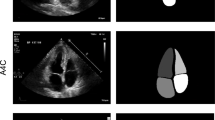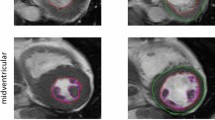Abstract
Deep learning algorithms for left ventricle (LV) segmentation are prone to bias towards the training dataset. This study assesses sex- and age-dependent performance differences when using deep learning for automatic LV segmentation. Retrospective analysis of 100 healthy subjects undergoing cardiac MRI from 2012 to 2018, with 10 men and women in the following age groups: 18–30, 31–40, 41–50, 51–60, and 61–80 years old. Subjects underwent 1.5 T, 2D CINE SSFP MRI. 35 pathologic cases from local clinical exams and the SCMR 2015 consensus contours dataset were also analyzed. A fully convolutional network (FCN) similar to U-Net trained on the U.K. Biobank was used to automatically segment LV endocardial and epicardial contours. FCN and manual segmentation were compared using Dice metrics and measurements of end-diastolic volume (EDV), end-systolic volume (ESV), mass (LVM), and ejection fraction (LVEF). Paired t-tests and linear regressions were used to analyze measurement differences with respect to sex and age. Dice metrics (median ± IQR) for n = 135 cases were 0.94 ± 0.04/0.87 ± 0.10 (ED endocardium/ES endocardium). Measurement biases (mean ± SD) among the healthy cohort were − 0.3 ± 10.1 mL for EDV, − 6.7 ± 9.6 mL for ESV, 4.6 ± 6.4% for LVEF, and − 2.2 ± 11.0 g for LVM; biases were independent of sex and age. Biases among the 35 pathologic cases were 0.1 ± 19 mL for EDV, − 4.8 ± 19 mL for ESV, 2.0 ± 7.6% for LVEF, and 1.0 ± 20 g for LVM. In conclusion, automatic segmentation by the Biobank-trained FCN was independent of age and sex. Improvements in end-systolic basal slice detection are needed to decrease bias and improve precision in ESV and LVEF.




Similar content being viewed by others
Data availability
Will be made available upon request.
Code availability
Will be made available upon request.
References
La Gerche A, Claessen G, Van De Bruaene A, Pattyn N, Van Cleemput J, Gewillig M et al (2013) Cardiac MRI: a new gold standard for ventricular volume quantification during high-intensity exercise. Circ Cardiovasc Imaging 6:329–338
Grothues F, Smith GC, Moon JC, Bellenger NG, Collins P, Klein HU et al (2002) Comparison of interstudy reproducibility of cardiovascular magnetic resonance with two-dimensional echocardiography in normal subjects and in patients with heart failure or left ventricular hypertrophy. Am J Cardiol 90:29–34. https://doi.org/10.1016/S0002-9149(02)02381-0
Hendel RC, Patel MR, Kramer CM, Poon M, Hendel RC, Carr JC et al (2006) ACCF/ACR/SCCT/SCMR/ASNC/NASCI/SCAI/SIR 2006 appropriateness criteria for cardiac computed tomography and cardiac magnetic resonance imaging. J Am Coll Cardiol 48:1475–1497. https://doi.org/10.1016/j.jacc.2006.07.003
Hundley WG, Bluemke DA, Finn JP, Flamm SD, Fogel MA, Friedrich MG et al (2010) ACCF/ACR/AHA/NASCI/SCMR 2010 expert consensus document on cardiovascular magnetic resonance. J Am Coll Cardiol 55:2614–2662. https://doi.org/10.1016/j.jacc.2009.11.011
Hautvast GLTF, Salton CJ, Chuang ML, Breeuwer M, O’Donnell CJ, Manning WJ (2012) Accurate computer-aided quantification of left ventricular parameters: experience in 1555 cardiac magnetic resonance studies from the Framingham Heart Study. Magn Reson Med 67:1478–1486. https://doi.org/10.1002/mrm.23127
Queirós S, Barbosa D, Engvall J, Ebbers T, Nagel E, Sarvari SI et al (2016) Multi-centre validation of an automatic algorithm for fast 4D myocardial segmentation in cine CMR datasets. Eur Hear J—Cardiovasc Imaging 17:1118–1127. https://doi.org/10.1093/ehjci/jev247
Miller CA, Jordan P, Borg A, Argyle R, Clark D, Pearce K et al (2013) Quantification of left ventricular indices from SSFP cine imaging: impact of real-world variability in analysis methodology and utility of geometric modeling. J Magn Reson Imaging 37:1213–1222. https://doi.org/10.1002/jmri.23892
Suinesiaputra A, Bluemke DA, Cowan BR, Friedrich MG, Kramer CM, Kwong R et al (2015) Quantification of LV function and mass by cardiovascular magnetic resonance: multi-center variability and consensus contours. J Cardiovasc Magn Reson 17:1–8. https://doi.org/10.1186/s12968-015-0170-9
Tran PV (2016) A fully convolutional neural network for cardiac segmentation in short-axis MRI. 1–21. https://doi.org/10.21437/Interspeech.2017-1465
Avendi MR, Kheradvar A, Jafarkhani H (2016) A combined deep-learning and deformable-model approach to fully automatic segmentation of the left ventricle in cardiac MRI. Med Image Anal 30:108–119. https://doi.org/10.1016/j.media.2016.01.005
Bai W, Sinclair M, Tarroni G, Oktay O, Rajchl M, Vaillant G et al (2018) Automated cardiovascular magnetic resonance image analysis with fully convolutional networks. J Cardiovasc Magn Reson 20:65. https://doi.org/10.1186/s12968-018-0471-x
Qin W, Wu Y, Li S, Chen Y, Yang Y, Liu X et al (2020) Automated segmentation of the left ventricle from MR cine imaging based on deep learning architecture. Biomed Phys Eng Express 6:025009. https://doi.org/10.1088/2057-1976/ab7363
Tao Q, Yan W, Wang Y, Paiman EHM, Shamonin DP, Garg P et al (2019) Deep learning–based method for fully automatic quantification of left ventricle function from cine MR images: a multivendor, multicenter study. Radiology 290:81–88. https://doi.org/10.1148/radiol.2018180513
Wang Y, Zhang Y, Wen Z, Tian B, Kao E, Liu X et al (2021) Deep learning based fully automatic segmentation of the left ventricular endocardium and epicardium from cardiac cine MRI. Quant Imaging Med Surg 11:1600–1612. https://doi.org/10.21037/qims-20-169
Eng J, McClelland RL, Gomes AS, Hundley WG, Cheng S, Wu CO et al (2016) Adverse left ventricular remodeling and age assessed with cardiac MR imaging: the multi-ethnic study of atherosclerosis. Radiology 278:714–722. https://doi.org/10.1148/radiol.2015150982
Schulz-Menger J, Bluemke DA, Bremerich J, Flamm SD, Fogel MA, Friedrich MG et al (2013) Standardized image interpretation and post processing in cardiovascular magnetic resonance: Society for Cardiovascular Magnetic Resonance (SCMR) Board of Trustees Task Force on Standardized Post Processing. J Cardiovasc Magn Reson 15:1–19
Golan R, Sojoudi A, Gao X, Wei Q, Barckow P, Fung K et al (2018) Automatic ventricular segmentation using a convolutional neural network: results from Circle Cardiovascular Imaging on UK Biobank cardiac MR CINE images. In: Society of Cardiovascular Magnetic Resonance. Barcelona
Maior LS, Ghazanfari A, Golan R, Amir-khalili A, Paiva JM, Fung K et al (2019) Automatic end-systolic phase detection on short axis CMR images based on minimum endocardium area of middle slice performs well compared to manual analysis. In: Society of Cardiovascular Magnetic Resonance. Bellevue
Fry A, Littlejohns TJ, Sudlow C, Doherty N, Adamska L, Sprosen T et al (2017) Comparison of sociodemographic and health-related characteristics of UK biobank participants with those of the general population. Am J Epidemiol 186:1026–1034. https://doi.org/10.1093/aje/kwx246
Ghadimi S, Auger DA, Feng X, Sun C, Meyer CH, Bilchick KC et al (2021) Fully-automated global and segmental strain analysis of DENSE cardiovascular magnetic resonance using deep learning for segmentation and phase unwrapping. J Cardiovasc Magn Reson 23:20. https://doi.org/10.1186/s12968-021-00712-9
Suinesiaputra A, Sanghvi MM, Aung N, Paiva JM, Zemrak F, Fung K et al (2018) Fully-automated left ventricular mass and volume MRI analysis in the UK Biobank population cohort: evaluation of initial results. Int J Cardiovasc Imaging 34:281–291. https://doi.org/10.1007/s10554-017-1225-9
Codreanu I, Robson MD, Golding SJ, Jung BA, Clarke K, Holloway CJ (2010) Longitudinally and circumferentially directed movements of the left ventricle studied by cardiovascular magnetic resonance phase contrast velocity mapping. J Cardiovasc Magn Reson 12:48. https://doi.org/10.1186/1532-429X-12-48
Casanova JD, Carrillo JG, Jiménez JM, Muñoz JC, Esparza CM, Alvárez MS et al (2020) Trabeculated myocardium in hypertrophic cardiomyopathy: clinical consequences. J Clin Med 9:3171. https://doi.org/10.3390/jcm9103171
Akhtari S, Chuang ML, Salton CJ, Berg S, Kissinger KV, Goddu B et al (2018) Effect of isolated left bundle-branch block on biventricular volumes and ejection fraction: a cardiovascular magnetic resonance assessment. J Cardiovasc Magn Reson 20:66. https://doi.org/10.1186/s12968-018-0457-8
Acknowledgements
The authors thank Bradley Allen, M.D., for providing a set of manually annotated clinical cases.
Funding
National Heart Lung and Blood Institute (HL117888).
Author information
Authors and Affiliations
Contributions
All authors contributed to the study conception and design. Material preparation, data collection and analysis were performed by VC, RG, MS, and HH. The first draft of the manuscript was written by VC and all authors commented on previous versions of the manuscript. All authors read and approved the final manuscript.
Corresponding author
Ethics declarations
Conflict of interest
Three authors on this study work for Circle Cardiovascular Imaging (RG, QW, AS). All other authors have no disclosures to report.
Ethical approval
This study was approved by the local institutional review board, and written informed consent was obtained from all participants.
Additional information
Publisher's Note
Springer Nature remains neutral with regard to jurisdictional claims in published maps and institutional affiliations.
Rights and permissions
About this article
Cite this article
Chen, V., Barker, A.J., Golan, R. et al. Effect of age and sex on fully automated deep learning assessment of left ventricular function, volumes, and contours in cardiac magnetic resonance imaging. Int J Cardiovasc Imaging 37, 3539–3547 (2021). https://doi.org/10.1007/s10554-021-02326-9
Received:
Accepted:
Published:
Issue Date:
DOI: https://doi.org/10.1007/s10554-021-02326-9




